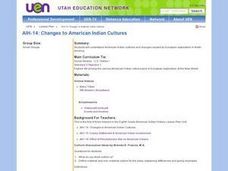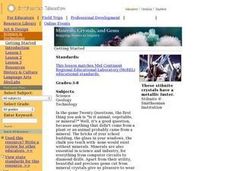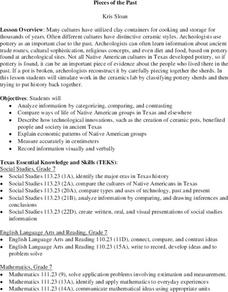Curated OER
AIH-14: Changes to American Indian Cultures
Students explore American Indian cultures and changes caused by European exploration in North America.
Curated OER
The Uluburun Shipwreck Project: Interconnections through Trade in the Late Bronze Age Mediterranean World
Ninth graders examine causes and effects of the Uluburun shipwreck. In groups, they develop their own ways to categorize the artifacts found on the ship and decide on the research questions they are going to focus on. They use the...
Curated OER
Introduction to Indians and the First Thanksgiving
Students use yarn to create a timeline of the first Thanksgiving. After a class discussion, they view pictures of artifacts and Native Americans to identify the tools and items present during the first Thanksgiving. In groups, they...
Curated OER
Climate and Cultures of Africa
Students gain an understanding of the relationship between climate and culture in the sub- Saharan Africa. Students will complete short exercises pertaining to the various cultures of Africa and the climate in which they live....
Curated OER
Minerals, Crystals, and Gems
Students discover the relationships between minerals, crystals and gems. They bring in rocks that they find at home, in the schoolyard, etc. and examine them and attempt to identify them. They set up a classroom exhibit that includes all...
Curated OER
CSI: Native America
Students discuss the murders of Native Americans in Indiana. In groups, they research and make drawings of the scene as if they were part of a CSI team. They complete any needed experiments to help them solve the crime and create a...
Alabama Learning Exchange
Would you fit in with the Cherokees?
Students use this activity as an introduction to the unit on Cherokee Native Americans. They discuss and research Cherokee dress and homes and identify difference between the Cherokee and the individuals in the class.
Curated OER
Pieces of the Past
Seventh graders compare and contrast the way of life of Native Americans in Texas and around the country. As a class, they brainstorm about the uses of pottery today and use broken pieces of pottery to create an artifact. In groups,...
Curated OER
STONEHENGE
Students work in cooperative groups to create a theory about the origin of Stonehenge. Each member of the group has a specific role, responsibilities and tasks. The group work can be implemented as a scaffolding technique.
Curated OER
How Things Fly
Students observe photographs of selected twentieth-century aircraft at the National Air and Space Museum and note differences in the design of aircraft wings, fuselages, and engines.
Curated OER
Pictures Telling Stories
Students see the importance of primary sources in the study of history, but also the limitations of relying only on primary sources of taking the money, as it were, at face value.
Curated OER
Creatures from Planet X: Spiders
Students are given a description of some fascinating animals from "Planet X". They follow the descriptions given to illustrate one of these animals paying careful attention to introduced vocabulary such as 'appendages', 'receptors', and...
Curated OER
Spy on a Spider
Students view slides or live specimens to name and describe the distinguishing features of groups of arthropods, especially spiders and insects. They complete worksheets, observe webs and then search for and record where spiders can be...
Curated OER
Lewis and Clark: The Language of Discovery
Students replicate some of the trailblazing methods of Lewis and Clark on a fifteen-minute "writing journey" through the school or neighborhood.
Curated OER
How Things Fly
Students, by drawing on their own experiences, discuss and examine the basic physics of flight. They participate in a variety of activities regarding flight.
Curated OER
Money Talks
Students move from fact finding to interpretation as they examine paper money from the time of the American Revolution. In the final exercise, they use the issue dates of the bills to construct a chronology of political changes during...
Curated OER
Trash...it really piles up!
Students investigate a contemporary "midden" by analyzing trash collected from various sources and determining life-style choices people make. They see that reducing the amount of waste we generate is helpful to the the environment.


















